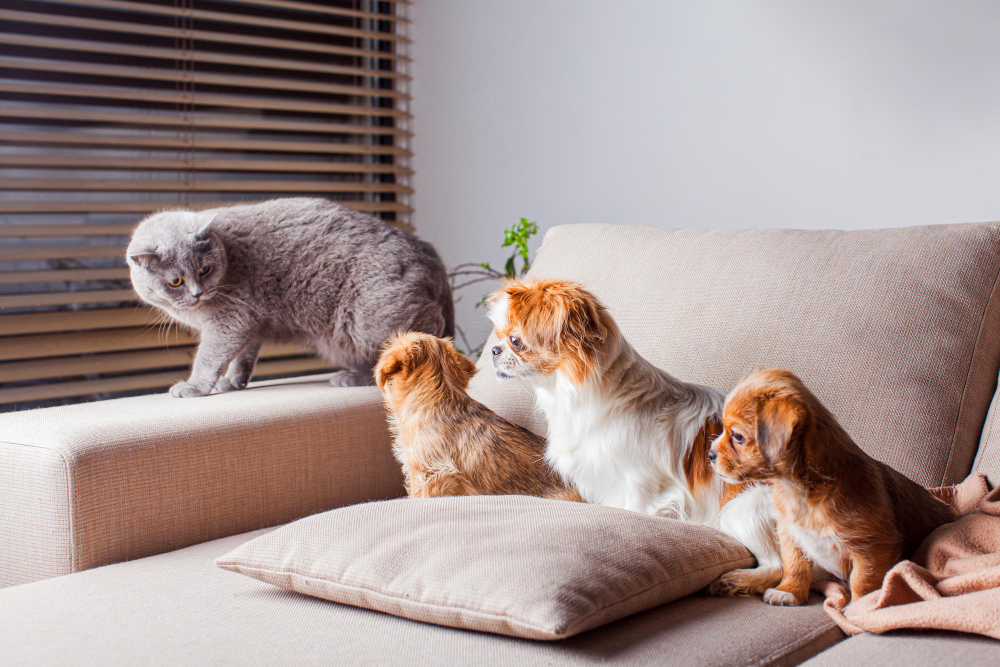Socialization is not just a buzzword in the pet world; it’s a critical developmental process that shapes how animals interact with each other and adapt to various environments. The notion that dogs and cats are arch-enemies is a myth that has been debunked by behavioral science. In reality, both species can coexist peacefully and even form strong bonds, provided they are socialized correctly. This comprehensive guide aims to equip you with the knowledge and tools needed for effective socialization, ensuring a happier, healthier life for your furry companions.
Understanding Socialization: The Basics
Socialization is a multifaceted developmental process that goes beyond mere interaction between animals. It encompasses how an animal learns to communicate and relate not just with other animals, but also with humans. The process extends to how they adapt to various environments, stimuli such as sounds and smells, and even different situations like car rides or vet visits.
The significance of socialization is most pronounced during the early stages of an animal’s life, particularly during the “puppy phase.” During this critical period, the brain is in a rapid state of development and is highly receptive to learning new behaviors and skills. Proper socialization is not a luxury; it’s a necessity for the emotional and psychological well-being of pets. It ensures that animals coexisting in the same environment feel safe, comfortable, and are less likely to exhibit stress or aggression.
Behavioral Differences: Dogs vs. Cats
Understanding the inherent behavioral traits of dogs and cats is crucial for effective socialization.
Dogs: The Social Butterflies
Dogs are inherently social creatures, thriving on interaction with both humans and other animals. They are generally easier to train and more willing to follow commands. Their adaptability to new environments and situations is often more seamless compared to cats.
Cats: The Independent Spirits
Cats, on the other hand, are more independent and may not seek out social interaction as actively as dogs do. They can be more challenging to train and may react aggressively when they feel threatened. Cats value their personal space and are often more selective about their social interactions.
It’s important to note that these are general traits, and individual personalities can vary. Therefore, customizing your socialization approach based on each pet’s unique characteristics is crucial.
The Ideal Time for Socialization: The Puppy Phase
The early developmental stages offer a golden opportunity for socialization, often referred to as the “puppy phase.” For dogs, this critical window opens between 3 and 14 weeks of age. During this period, they are exceptionally receptive to new experiences, making it an ideal time for exposure to various stimuli, environments, and other animals. For cats, the optimal socialization period is slightly shorter, occurring between 3 and 9 weeks of age. During this phase, cats are more amenable to adapting to new surroundings, sounds, and situations.
If you’re considering raising both dogs and cats, acquiring them simultaneously during their respective puppy phases can significantly enhance the socialization process. The younger the animals are when they start socializing, the more effective the process will be, leading to a more harmonious coexistence in the long run.
Socializing Adult Pets: Challenges and Solutions
Now, if you already have an adult pet at home and want to socialize it with another puppy dog or cat, or vice versa, the process can be more intricate. Here are some actionable tips:
- Initial Isolation: Start by keeping the animals in separate rooms. This allows them to get used to each other’s scent without the immediate stress of a face-to-face encounter.
- Supervised Interactions: Once they seem comfortable with each other’s scent, initiate short, supervised meetings in a neutral space. Gradually extend the time they spend together as they show signs of comfort and acceptance.
- Treats and Praise: Positive reinforcement is key. Reward good behavior with treats and verbal affirmations. Opt for nutritious options like fruits and vegetables for treats. For more insights on healthy snacks, check out this nutritious guide.
- Basic Commands: It’s crucial to teach basic commands like “sit,” “stay,” and “down” to both pets. This not only makes it easier to manage their behavior during interactions but also helps in preventing potential conflicts.
- Signs of Discomfort: Always be vigilant for signs of stress or discomfort from either animal. Cats, being generally more independent, often need more time to adjust. It’s essential to respect their need for space and not to rush the socialization process.
- Calming Agents: Consider using pheromone diffusers or sprays to help create a calming environment.
- Catnip: This can be particularly useful for making the environment more appealing to the cat. For a deeper understanding of catnip’s effects, refer to this informative article.
- Body Language: Pay close attention to each pet’s body language during their interactions. If you notice any signs of tension or discomfort, it’s advisable to separate them and try again later.
- Behavioral Expert: If, despite your best efforts, the pets are not getting along, consult a professional animal behaviorist for specialized advice tailored to your pets’ unique needs.
By meticulously following these guidelines, you set the stage for a more harmonious relationship between your adult pet and the new addition to your family.
When All Else Fails: Seek Professional Help
If you’ve tried all the above strategies and still find that your pets are not getting along, it may be time to seek professional help. Consulting a certified animal behaviorist can offer a more targeted approach to socialization. These experts can observe the specific behaviors and interactions between your pets, identifying the root causes of the issues. They employ a range of techniques, including conditioning training and behavioral modification, to tailor the socialization process according to the unique characteristics and personalities of your animals.
The behaviorist can also provide you with a customized training regimen and may recommend specific tools or products that can aid in the socialization process. Remember, every animal is different, and some may require more time and specialized attention to adapt to new companions. Therefore, professional intervention can be invaluable in resolving more severe behavioral problems and ensuring a peaceful coexistence between your pets.
Conclusion
In conclusion, the journey to successful socialization between dogs and cats is a nuanced endeavor that requires a deep understanding of animal behavior, strategic planning, and consistent effort. Whether you’re starting with puppies or introducing an adult pet to a new companion, the key lies in gradual exposure, positive reinforcement, and respecting each animal’s unique personality. If challenges persist, don’t hesitate to seek the expertise of a certified animal behaviorist for specialized guidance. By adhering to these principles and guidelines, you’re not just preventing potential conflicts; you’re enriching the lives of your pets, setting the stage for a harmonious and emotionally fulfilling coexistence.

